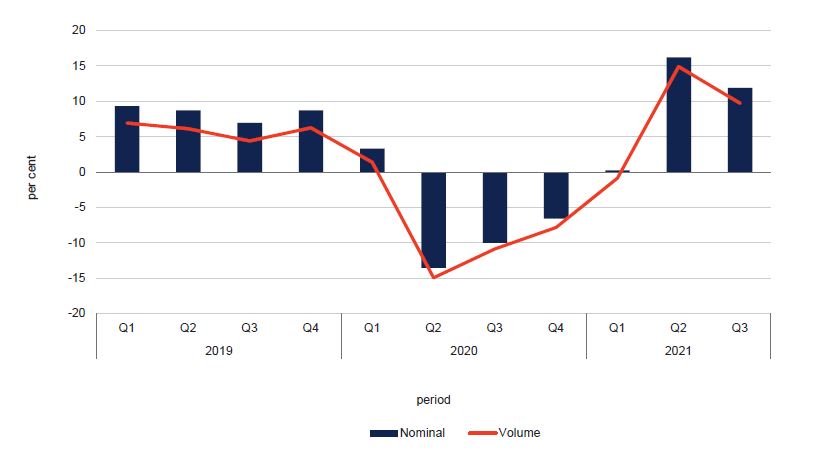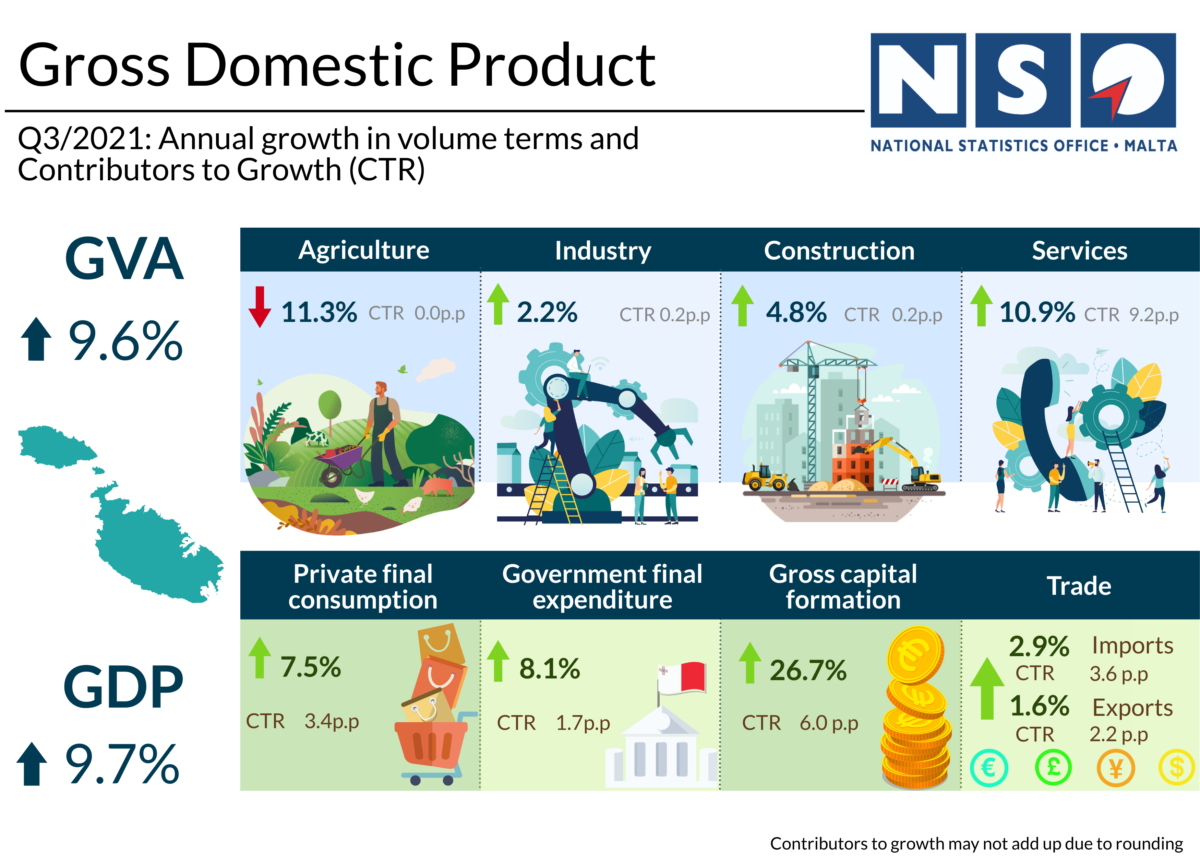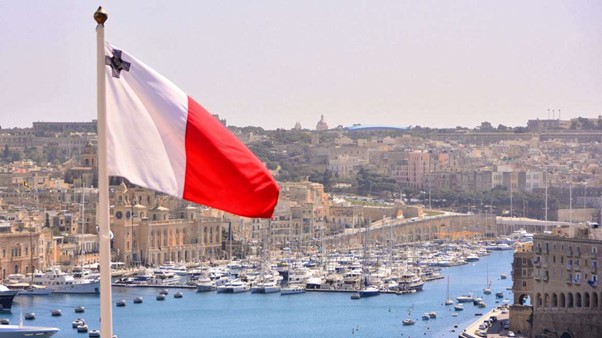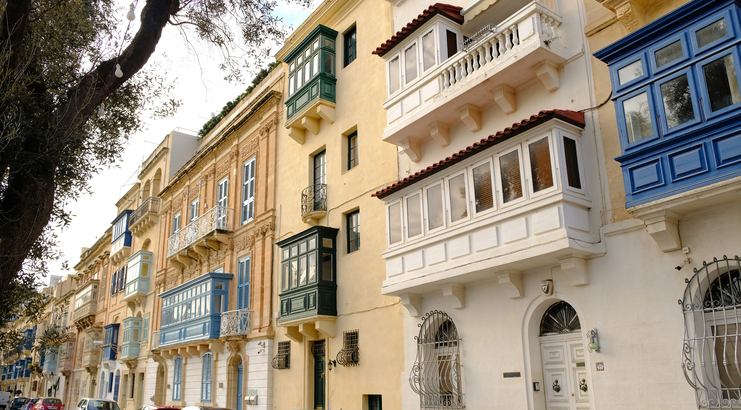Malta’s Gross Domestic Product (GDP) for the third quarter of 2021 amounted to €3,705.9 million, registering an increase of €394.4 million, or 11.9 per cent year-on-year (YOY) growth rate when compared to the same quarter of 2020, largely driven by service activities like transportation, accommodation, food services, retail trade and ICT.
According to a release on GDP from the National Statistics Office, the areas with the highest Q3 increase over the corresponding period of the previous year were the transport and storage sector, the accommodation and food service sector, wholesale and retail trade, and information and communication activities.
Although summer of 2020 came as a welcome period of respite from the COVID-19 restrictions that preceded and followed it, this year’s summer was better. While 2021 remains far off from 2019’s record numbers, the decent tourism activity likely accounts for much of the increase in GDP generated from services.
In volume terms, Malta’s GDP rose by 9.7 per cent between July and September of this year, following the drop of 10.9 per cent registered a year earlier as a result of the pandemic.

GDP is calculated using three methods:
The production approach
During the third quarter of 2021, Gross Value Added (GVA) rose by 11.6 per cent in nominal terms and by 9.6 per cent in volume terms, when compared to the same quarter of 2020.
The main drivers behind this 9.6 per cent growth were service activities, industry, and construction, with a contribution of 9.2 percentage points, 0.2 percentage points, and 0.2 percentage points, respectively.
Agriculture and fishing had a neutral impact on GVA growth.
Compared to the same quarter last year, service activities increased by 10.9 per cent, industry by 2.2 per cent and construction by 4.8 per cent in volume terms. A drop of 11.3 per cent was recorded in agriculture and fishing activities.

The increase in services was mainly driven by the following sectors: transportation and storage (87 per cent), accommodation and food service activities (79.5 per cent), wholesale and retail trade, repair of motor vehicles and motorcycles (18.8 per cent), and information and communication activities (13.2 per cent).
Net taxes on products contributed positively towards GDP growth with an increase of 10.5 per cent in volume terms.
The expenditure approach
The expenditure approach is another method used to calculate GDP and is derived by adding final consumption expenditure of households, non-profit institutions serving households (NPISH) and general government, gross capital formation (GCF) and net exports.
The contribution of domestic demand to the year-on-year GDP growth rate in volume terms was of 11.1 percentage points, of which 5.1 were due to final consumption expenditure and 6 to gross capital formation.
External demand registered a negative contribution of 1.4 percentage points, with 2.2 percentage points attributable to exports, and 3.6 percentage points explained by imports.
In the third quarter of 2021, total final consumption expenditure witnessed an increase of 7.7 per cent in volume terms. This was the result of an increase in household expenditure of 7.6 per cent, an increase in Government expenditure of 8.1 per cent, and an increase in NPISH expenditure of 2.9 per cent.
Gross fixed capital formation (GFCF) rose by 32.5 per cent in volume terms. This increase was mainly attributable to investment in transport equipment.
Exports and imports of goods and services in volume terms increased by 1.6 per cent and 2.9 per cent respectively.
The income approach
The third approach to measure economic activity is the income approach, which shows how GDP is distributed among compensation of employees, operating surplus of enterprises and taxes on production and imports net of subsidies.
Compared to the third quarter of 2020, the €394.4 million increase in nominal GDP was the result of a rise in all the sub-components of the income approach, with an increase of €125.3 million in compensation of employees, €181.3 million in gross operating surplus and mixed income, and €87.8 million in net taxation on production and imports.
Gross National Income (GNI)
The GNI differs from the GDP measure in terms of net compensation receipts, net property income receivable and net taxes receivable on production and imports from abroad.
Considering the effects of income and taxation paid and received by residents to and from the rest of the world, GNI at market prices for the third quarter of 2021 was estimated at €3,453.9 million.
European Parliament adopts regulation making it easier for companies to be paid on time
The maximum credit term under the new Late Payment Regulation is to up to 120 days, for some sectors
French ATC strike forces Ryanair to cancel over 300 flights, affecting 50,000 passengers
The low-cost carrier is demanding the EU carries out reforms to ensure travel continues undisrupted
Valletta ranks 8th most expensive European capital city to live in – study
While London is the most expensive, Bucharest is the most affordable






